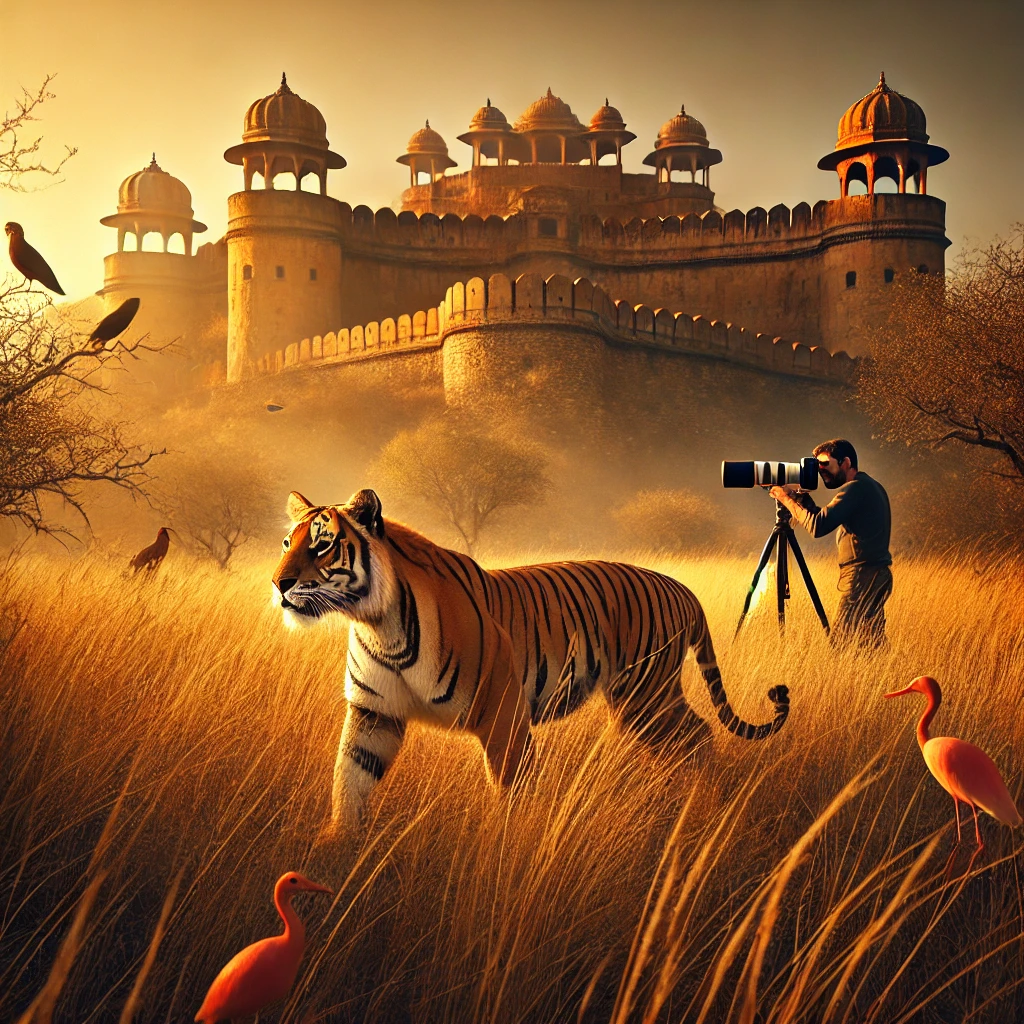The Magic of Wildlife Photography in Rajasthan
Rajasthan is famous for its rich history, grand palaces, and golden deserts. But beyond its cultural heritage, this Indian state is a paradise for wildlife photographers. From elusive tigers in Ranthambore to rare migratory birds in Bharatpur, Rajasthan offers diverse landscapes and species for breathtaking wildlife photography. Whether you’re an amateur or a seasoned photographer, knowing the right locations and techniques will enhance your portfolio.
This guide explores the best places for wildlife photography in Rajasthan, offering expert tips on capturing the region’s unique biodiversity.
1. Ranthambore National Park: The Tiger’s Den
Why Visit?
Ranthambore National Park is Rajasthan’s most famous wildlife sanctuary, known for its high population of Royal Bengal Tigers. The park also features leopards, sloth bears, marsh crocodiles, and various bird species.
Best Photography Spots:
- Padam Talao – Ideal for capturing tigers near water.
- Rajbagh Ruins – Offers a historic backdrop for wildlife shots.
- Malik Talao – Home to crocodiles and numerous bird species.
Photography Tips:
- Visit during early morning or late afternoon for the best lighting.
- Use a telephoto lens (400mm or higher) for close-up tiger shots.
- Capture candid animal behavior for compelling storytelling.
2. Keoladeo National Park: A Bird Photographer’s Dream
Why Visit?
Keoladeo National Park, also known as Bharatpur Bird Sanctuary, is a UNESCO World Heritage Site and one of Asia’s finest bird sanctuaries.
Best Photography Spots:
- Sapan Mori – Great for capturing migratory birds in the winter.
- Shanti Kutir – A hotspot for nesting birds.
- Keoladeo Temple – Home to large colonies of painted storks.
Photography Tips:
- Use a zoom lens (200-500mm) to capture detailed shots of birds in flight.
- Visit during winter (November–March) for maximum bird diversity.
- Experiment with different angles to create dynamic compositions.

3. Sariska Tiger Reserve: A Hidden Gem
Why Visit?
Though lesser-known than Ranthambore, Sariska Tiger Reserve offers excellent wildlife photography opportunities, featuring tigers, leopards, hyenas, and nilgai.
Best Photography Spots:
- Pandupol Temple Area – Frequented by wildlife.
- Siliserh Lake – Great for bird photography.
- Kankwari Fort – Provides a unique historic backdrop for wildlife shots.
Photography Tips:
- Patience is key when capturing tigers and leopards.
- Use a tripod for stability, especially in low-light conditions.
- Try black-and-white photography to highlight the park’s raw wilderness.
4. Desert National Park: Wildlife Amidst Sand Dunes
Why Visit?
Unlike typical forests, Desert National Park showcases Rajasthan’s arid landscape and is home to the critically endangered Great Indian Bustard.
Best Photography Spots:
- Sudashri Watch Tower – Ideal for spotting bustards.
- Sam Sand Dunes – Offers breathtaking sunset shots.
- Gadsisar Lake – Great for capturing birds and landscapes.
Photography Tips:
- Use a wide-angle lens to emphasize the vast desert expanse.
- Capture wildlife footprints in the sand to add a storytelling element.
- Use natural light during sunrise and sunset for stunning golden hues.
5. Kumbhalgarh Wildlife Sanctuary: The Leopard’s Domain
Why Visit?
Located around the famous Kumbhalgarh Fort, this sanctuary is home to leopards, wolves, and jungle cats.
Best Photography Spots:
- Thandi Beri Waterhole – Animals frequent this area.
- Kumbhalgarh Fort Periphery – Offers a panoramic view of wildlife.
- Banas River Bank – Great for spotting wolves and hyenas.
Photography Tips:
- Leopards are most active during dawn and dusk—plan accordingly.
- Use silent shutter mode to avoid disturbing wildlife.
- Capture the fort’s silhouette in the background for a cinematic effect.
6. Mount Abu Wildlife Sanctuary: A Green Oasis
Why Visit?
Unlike the arid landscapes of Rajasthan, Mount Abu Wildlife Sanctuary is lush and green, hosting black bears, sambars, and langurs.
Best Photography Spots:
- Guru Shikhar – Highest peak for landscape photography.
- Trevor’s Tank – Home to crocodiles and migratory birds.
- Salgaon Trail – Great for spotting bears and langurs.
Photography Tips:
- Bring a waterproof camera cover for misty conditions.
- Capture reflections in the water for creative shots.
- Use a fast shutter speed to freeze animal movements.
Conclusion: Capturing Rajasthan’s Wild Beauty
Rajasthan offers an extraordinary range of wildlife photography opportunities. From the tiger territory of Ranthambore to the bird haven of Keoladeo, each location presents unique challenges and rewards. By choosing the right equipment, exploring at the right time, and applying expert photography techniques, you can create a stunning wildlife portfolio that showcases Rajasthan’s diverse ecosystem.
So pack your gear, head into the wilderness, and let Rajasthan’s wildlife tell its own story through your lens.
Key Takeaways:
- Best time for wildlife photography: Early mornings and late afternoons.
- Essential gear: Telephoto lens, tripod, fast memory cards, and a good DSLR or mirrorless camera.
- Respect nature: Avoid disturbing animals and maintain ethical photography practices.
Stay tuned for more wildlife photography tips at The Candid Shoot!

Sony Alpha a7 IV: The Ultimate Camera for Photography

Nikon Z5 Review: Is It Worth It?
-

Nikon Z9 : Game-Changer for Photography
-

Top Features of Nikon D850 That Make It Ideal for Portfolio Shoots
Sony Alpha a7 IV: The Ultimate Camera for Photography
Explore the Sony Alpha a7 IV in this complete 2025 review. Learn how its pro-level features, real-world performance, and hybrid flexibility make it the ultimate camera for photography across genres like portraits, weddings, travel, and commercial work. Table of Contents Section 1: Introduction – Why the Sony Alpha a7 IV Stands Out The Sony Alpha…
Nikon Z5 Review: Is It Worth It?
In 2025, photographers—whether hobbyists, content creators, or professionals—seek equipment that blends value, performance, and future-readiness. Enter the Nikon Z5, a full-frame mirrorless camera marketed as a gateway to high-end imaging without a flagship price tag. But how well does it hold up under real-world demands like studio shoots, weddings, landscape adventures, and lifestyle photography? In…
Nikon Z9 : Game-Changer for Photography
Discover why the Nikon Z9 is considered a true game-changer for photography. This in-depth Nikon Z9 review explores key features, real-world performance, and how it excels in professional photo shoots in 2025. Table of Contents 1. Introduction The photography world witnessed a significant shift with the launch of the Nikon Z9, a flagship mirrorless camera…
Top Features of Nikon D850 That Make It Ideal for Portfolio Shoots
Discover why the Nikon D850 is the ultimate DSLR for portfolio shoots. Explore its top features—from resolution and dynamic range to autofocus precision and workflow speed—that help photographers create stunning, high-impact images for professional portfolios. Whether you’re a portrait artist, fashion photographer, or visual storyteller, a portfolio shoot demands technical excellence, creative flexibility, and uncompromised…
Candid Moments with Canon EOS R10: Lightweight & Reliable
In the evolving world of mirrorless photography, the Canon EOS R10 stands out as a lightweight yet powerful camera tailored for real-life storytelling. Whether you’re photographing street scenes, family gatherings, weddings, or spontaneous portraits, capturing genuine emotion requires a responsive and discreet tool. This article dives deep into how the Canon EOS R10 excels in…
Bold Portraits with Canon EOS R5: Is It the Best for Work?
Studio photography has always demanded precision, artistry, and impeccable gear. As the expectations for commercial portraits, fashion campaigns, and editorial work continue to rise, the tools we use must evolve. Enter the Canon EOS R5, a camera that has stirred the professional waters with its impressive technical specs and forward-thinking design. In this comprehensive Canon…


